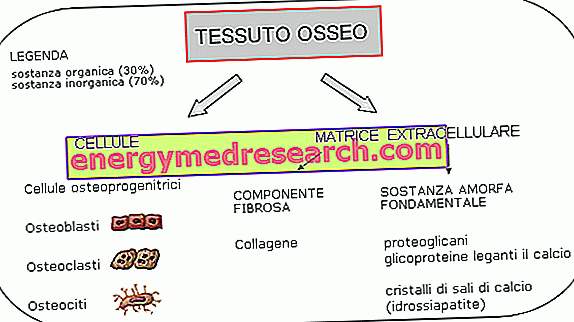Bone cells and bone renewal
Despite the characteristic mineralization, the bone is far from being a dead tissue. On the contrary, it is the site of intense cellular activity, so much so that every year about 10% of our bone mass is renewed, through physiological mechanisms of neo-formation and resorption. This means that:
- every 10 years the skeleton is completely renewed.
All of this involves structural modifications that are only microscopically detectable and that do not involve macroscopic changes in its shape (at least in adulthood).
Bone cells are educationally divided into four categories: osteocytes, osteoblasts, osteoclasts and their precursors. It is good to remember, from the beginning, that:
- osteoblasts are responsible for the formation of bone matrix
- osteoclasts are responsible for the disintegration of bone matrix
So let's focus on these two cell types. As for the osteoprogenitor cells (also called preosteoblasts), it is enough to know that they give rise to the other cell types and that they are found in large quantities in the endosteal and periosteal surfaces of the bone.

Osteoblasts
Osteoblasts are cells that specialize in bone production.
They have a globular or polyhedral shape, a monolayer; they tend to juxtapose each other by coating small areas of bone matrix, forming the so-called mineralization front.
Osteoblasts synthesize the various tissue components, both fibrous and amorphous, participating in the formation of the osteoid and in the regulation of its mineralization processes.
The osteoid is given by a support of collagen fibers aligned to form an organic matrix, on which the hydroxypatite crystals and other mineral components are bound. The collagen fibrils are arranged according to preferential lines of force, so as to give the bone properties of resistance to mechanical stresses.
In addition to type I collagen, which is assembled in fibrils in the extracellular spaces and acts as a support for mineralization, osteoblasts produce some proteins, such as osteocalcin and osteonectin, which perform a supporting action in the deposition process. calcified matrix.
It is believed that osteoblasts also play a role in the initial phases of the resorption process, through the processing of specific proteases and osteoclast activation factors.
Osteoblasts are cells of mesenchymal origin (the mesenchyme is the embryonic connective tissue that gives rise, for successive stages of development, to the adult connective tissue).
Osteoclasts
Osteoclasts are large cells, with a diameter ranging between 20 and 100 microns, with many nuclei, mobile and specialized in bone resorption.
Thanks to the numerous microvilli, the osteoclasts stick like suction cups to a section of bone matrix; they are generally accepted in small gaps called Howships. Here they secrete proteolytic acids and enzymes, digesting both the supporting collagen and the inorganic matrix and solubilizing the minerals it contains.
The reabsorption of bone tissue operated by osteoclasts plays an important role during the processes of regeneration and remodeling of bone tissue, but not only. These cells are indeed important for regulating calcium and phosphorus serum concentrations.
osteocytes
The secretion of the osteoblasts occurs according to a very precise orientation: initially it is polarized towards the pre-existing bone surface, but at regular intervals it is also addressed in the other directions; in this way the osteoblasts move away from each other and remain imprisoned in the matrix in the process of mineralization. Once "walled" it substantially slows down its metabolic activity and becomes osteocyte.
When osteoblasts have exhausted their function they enter a state of quiescence *, or they become less active cells, called osteocytes, which remain trapped in the calcified bone matrix. These, taken together, will constitute about 90% of the bone cellular heritage **.
It appears that the function of osteocytes is to participate in bone remodeling in response to various stimuli. Under the stimulation of calcitonin and parathormone, they also participate in the regulation of blood levels of calcium and phosphorus, controlling both the activity of osteoclasts and that of osteoblasts.
(*) When the formation process of new bone has been exhausted, some osteoblasts cease their activity, reduce their organelles and transform into a membrane of flattened cells (cells lining the bone or bone lining cells ).



